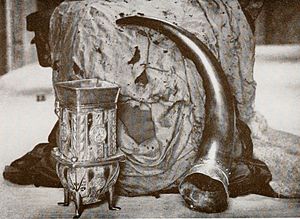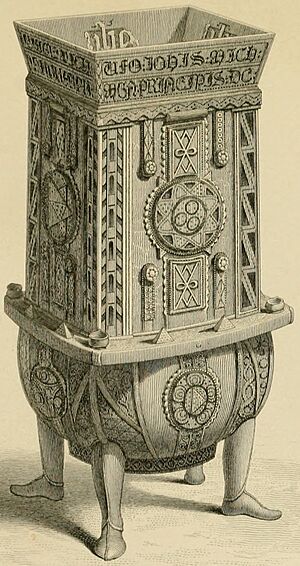Dunvegan Cup facts for kids
The Dunvegan Cup is a special wooden cup used for ceremonies. It is decorated with silver plates and was made in 1493. A woman named Caitríona asked for it to be made. She was the wife of John Maguire, a lord from Ireland.
The Dunvegan Cup is a very old family treasure. It belongs to the Macleod family who live at Dunvegan Castle. This castle is their main home. There are many old stories about how the Macleods got the cup. But experts think the family probably got it in the 1500s or 1600s. The Macleod chiefs have other famous treasures at Dunvegan Castle. These include the Fairy Flag and Sir Rory Mor's Horn.

Contents
What Does the Dunvegan Cup Look Like?
The Dunvegan Cup is a ceremonial cup made mostly of wood. It is beautifully decorated with silver. The top part of the cup is square, and the bottom part is round. It stands on four small legs.
In 1815, a writer named Sir Walter Scott looked at the cup. He said it was about 10.5 inches (27 cm) tall on the outside. It was about 9.75 inches (24.8 cm) deep inside. The widest part at the top was about 4.5 inches (11 cm). Later, around the 1850s, another expert named Alexander Nesbitt gave similar measurements. He added that the cup was about 5.5 inches (14 cm) wide at its broadest point.
Experts think the wood might be oak, yew, or alder. The cup is covered with thin silver decorations. These silver parts are made with fancy designs called filigree. This means the silver is twisted into delicate patterns. It also has black designs called niello and gold parts called gilding.
The top edge of the cup has a solid silver-gold rim. It is about 2 inches (5.1 cm) deep. On the outside of this rim, there is writing carved in black letters. The inside of the rim is mostly plain. But it has the letters I.H.S. repeated on all four sides. This is a special symbol representing Jesus Christ.
Each side of the cup has different designs of triangles and circles. Some people think these designs represent the Trinity and Eternity. There are also empty spots on the cup where stones or glass might have been. Some smaller spots still hold tiny beads of coral. The cup's silver legs look like human legs. They have twisted wire designs and wear shoes covered in black niello. The legs are also gilt (covered in a thin layer of gold).
Because the silver is very thin, the cup has been damaged over many years. The Dunvegan Cup is known as a mether. This is a type of communal drinking cup used for special events. Its square top and rounded bottom are typical features of a mether.
How Did the Dunvegan Cup Get Here?
Different Ideas About the Inscription
The silver rim of the cup has a Latin inscription (writing). Many people have tried to read and understand this inscription over the years. Their ideas about what it says have changed a lot.
Sir Walter Scott was one of the first to try. He thought the cup was from the year 993. He believed it was a drinking cup from the Hebrides islands. Scott also said that Macleod family stories claimed the cup once belonged to "Neil Ghlune-Dhu," or "Black-knee."
Later, in the 1850s, Sir Daniel Wilson studied the cup. He first agreed with Scott. But after seeing the cup himself, he changed his mind. Wilson believed the cup was made in Ireland, not Scotland. His new reading of the inscription said the cup belonged to "Katharina nig Ryneill." He thought the "John, son of the Maguire" mentioned in the inscription was a person from Irish history who died in 1511.
Around the same time, Eugene O'Curry also read the inscription. He said the woman's name was "Katherina ingen ui Neill," meaning she was an O'Neill. He also noticed that the last part of the inscription was from the 145th Psalm in the Bible. Both Wilson and O'Curry agreed that the cup was made in the year 1493.
Even later, Roderick Charles MacLeod read the inscription. He called the woman "Katharina Nig Ry Neil," meaning Katharina, daughter of King Neil. R.C. MacLeod also mentioned the old Macleod story that the cup belonged to Niall Glúndub. Niall Glúndub was an Irish king from the 900s. R.C. MacLeod thought the wooden part of the cup might be very old. But he believed the silver decorations were added later, possibly in the 14th century. The inscription itself clearly states the year 1493.
How the Cup Came to the Macleods
It's not clear exactly when the Macleods of Dunvegan got the cup. Some Macleod family stories say the cup came to them from fairies!
Fred T. MacLeod, an expert, thought the Macleods probably got the cup in the 1500s or 1600s. During that time, several Macleod chiefs fought in wars in Ireland. He thought the cup might have been taken as a prize during a war. Or, it could have been a gift for their help.
Later, in 1925, a Lady O'Neill wrote a letter. She said that an O'Neill family story explained how the cup went to the Macleods. This story says that an O'Neill chief and a Macleod chief were close friends. When the O'Neill chief visited his friend at Dunvegan, he brought the cup as a present.
Historically, in the 1590s, a Macleod chief helped Irish forces who were fighting against Queen Elizabeth I of England. In 1594, Ruairidh Mòr MacLeòid, the chief of the Macleods, sailed to Ireland with 500 men. They went to help Hugh Roe Ó Donnell who was attacking Enniskillen Castle. Ruairidh Mòr stayed in Ireland and was there when Enniskillen Castle fell in October 1594. He was still in Ireland the next year with 600 men.
Because Ruairidh Mòr was involved in these events in Ireland, R.C. MacLeod believed the cup was given to the Macleods by an O'Neill chieftain named Shane Ó Neill. He thought these two chiefs were the friends mentioned in the old family story.






